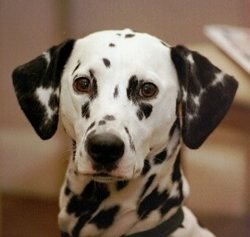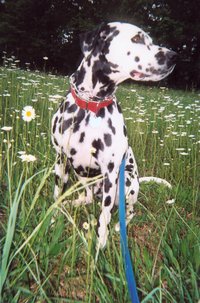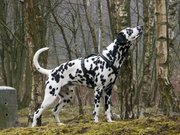Dalmatian
Dogs
Dalmatian
| Dalmatian |

Black spotted Dalmatian
|
| Alternative names |
| Dalmatinac |
| Country of origin |
|
Dalmatia (Croatia) |
| Common nicknames |
| Dal |
| Classification and breed standards |
|
FCI: |
Group 6 Section 3 #153 |
|
|
AKC: |
Non-sporting |
|
|
ANKC: |
Group 7 (Non-Sporting) |
|
|
CKC: |
Group 6 - Non-Sporting Dogs |
|
|
KC (UK): |
Utility |
|
|
NZKC: |
Non-sporting |
|
|
UKC: |
Companion Breeds |
|
| Not recognized by any major kennel club |
| This breed of dog is
extinct |
| Notes |
| |
A Dalmatian is a
breed of dog,
noted for its white coat with (usually) black spots. "Liver"
(brown) and "lemon"
(yellow) types also exist, though they are much
rarer. In the
US
Dalmatians are often known (and portrayed, for example in
children's books), as
firehouse dogs.
Appearance
This
popular
breed of dog is a well-muscled,
midsized dog with superior
endurance.
Known for its elegance, the Dalmatian has a body type similar to the
Pointer, to which it may be related. The
coat is short, dense,
and fine. The ground color is white with round, well-defined spots in either
black or liver (brown). Lemon, orange, blue, tricolor, and brindle spots can
also occur, but they are a disqualifying fault according to the breed standard.
The feet are round and compact with well-arched
toes. The
nails are either white and/or the same color as the spots. The nose can be
black or brown in liver-spotted dogs. The eyes are brown or blue, with an
intelligent expression. The
ears are thin,
tapering toward the tip, set fairly high and carried close to the head
Puppies are born completely white and the spots develop later.
Temperament
As a result of their history as coach dogs, the breed is very active and
needs plenty of exercise. They are quite affectionate and need constant
companionship or there is a risk they may become depressed. They are good with
children, but because of their playfulness, they may not be well-suited for
toddlers. Dalmatians are famed for their loyalty, good memories, and kindly
natures.
Reputation
 Dalmatian dog
Dalmatian dog
The Dalmatian's reputation as a firehouse dog appears to be rooted in the
popular use of the Dalmatian as a
carriage dog, that is, a dog whose role was to run along, beside, and
sometimes even under
horse-drawn carriages (therefore also known as Spotted Coach-dog).
Carriage dogs were useful for clearing the way in front of the carriage,
possibly for helping to control the horses when at a full run (such as for
horse-drawn fire engines), and undoubtedly because they were attractive and
eye-catching. This use might have transferred to horse-drawn fire engines
although it is unclear why this link is made in the US and not other countries.
However, their origins are as a generalized
working
dog. They were used for so many tasks--herding sheep, hunting in a pack, and
working as a
retriever and as a
bird dog--that
they were never specialized into one particular area.
Origins
The breed was named in the
18th
century after
Dalmatia.
However, it is believed to have existed for possibly centuries before it was
so named:
- 4000-year-old
Greek art
displays dogs that appear similar to the modern Dalmatian
- There is some evidence that it originated even before that in
India
- The breed could have originated from the Norman introduction of the
Talbot hunting dog whose image was the crest of the Talbot family, who
came to Britain with the original Norman invasion.
Health
Some Dals have a tendency towards
deafness,
as is the case with many mostly white or all-white dogs. Information from
Dalmatian clubs can usually address this issue for new owners. Some male
Dalmatians are aggressive towards other male dogs.
Dalmatians, like
humans, apes, and
guinea pigs,
lack an enzyme called uricase, which breaks down uric acid. Uric acid can build
up in joints and cause
gout or
kidney
stones. These conditions are most likely to occur in middle-aged males.
Owners should be careful to limit the intake of
purine by not
feeding these dogs organ meats in order to reduce the likelyhood of stones.
Miscellaneous
 Dalmatian in woods.
Dalmatian in woods.
The breed experienced a massive surge in popularity caused by the
1956
novel
The Hundred and One Dalmatians by
Dodie
Smith, and especially the
Disney films based on the book. At the time of the
1996 live action
film
101
Dalmatians concern was expressed that people, having seen the film,
would buy the dogs without thinking through the responsibilities of ownership:
for example, Dalmatians, having been bred to run with horses, need plenty of
exercise. It is not clear whether these concerns turned out to be correct,
although there is evidence that problems occurred in
1961 when the first
animated film,
One Hundred and One Dalmatians, was released.
External links
Home | Up | Dachshund | Dalmatian | Dandie Dinmont Terrier | Deerhound | Dobermann | Dogue de Bordeaux | Drentse Patrijshond
Dogs, made by MultiMedia | Free content and software
This guide is licensed under the GNU
Free Documentation License. It uses material from the Wikipedia.
|




